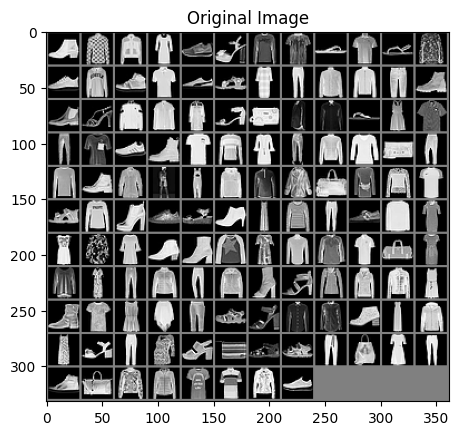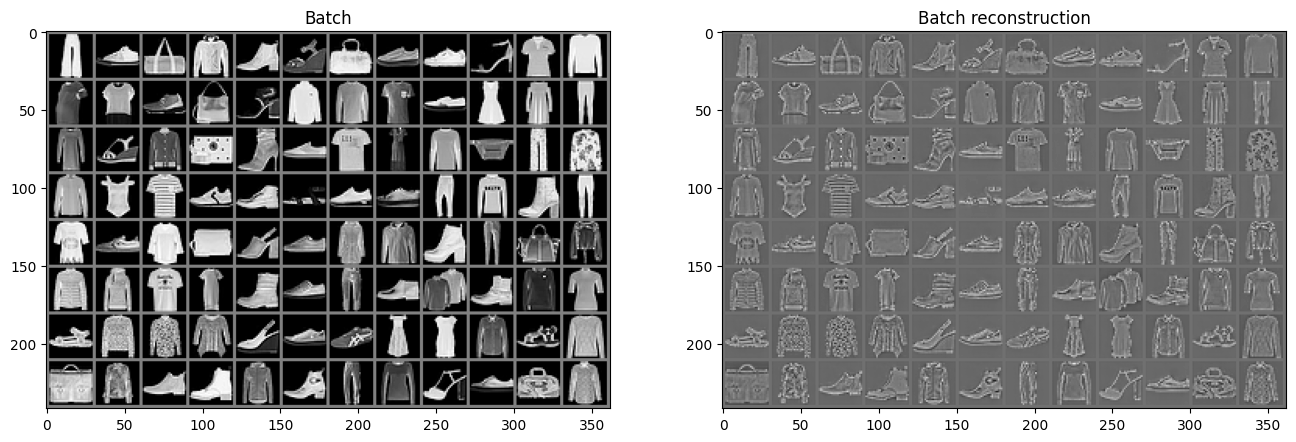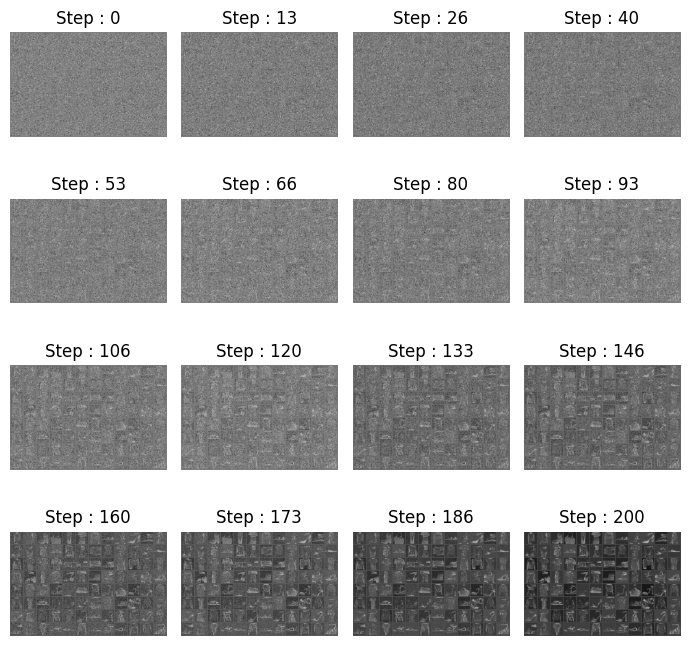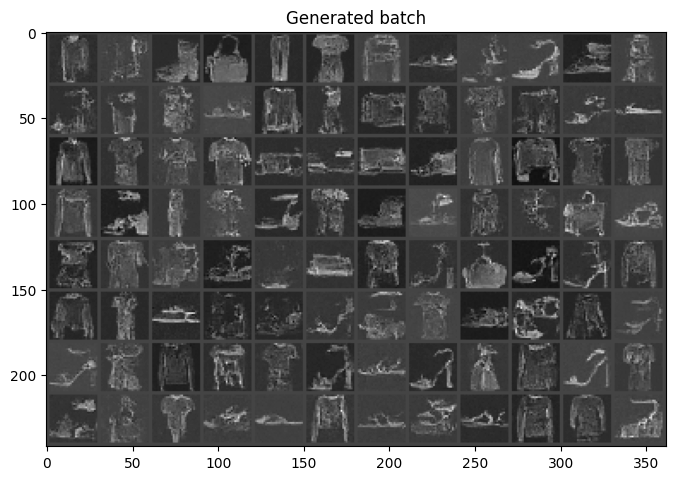DDPM
이번 페이지에서는 Stable Diffusion 알리리즘 중 DDPM을 이용해 생성형 모델을 학습하는 방법에 대해서 설명합니다.
Dataset
우선 튜토리얼에 들어가기에 앞서 사용할 데이터셋을 선언합니다. 데이터셋에 대한 자세한 설명은 Fashion-MNIST 페이지에서 확인할 수 있습니다.
from torchvision.transforms import Compose, ToTensor, Lambda
from torchvision.datasets.mnist import FashionMNIST
from torch.utils.data import DataLoader
transform = Compose(
[
ToTensor(),
Lambda(lambda x: (x - 0.5) * 2),
]
)
dataset = FashionMNIST("./datasets", download=True, train=True, transform=transform)
loader = DataLoader(dataset, batch_size=128, shuffle=True)
DDPM
이제 본격적으로 모델 코드를 작성해 보겠습니다.
DDPM 에서는 DPPM 알고리즘과 UNet 을 사용합니다.
Encoder & Decoder
이번 예제에서는 앞선 Vanila AutoEncoder 에서 사용한 블록을 사용합니다.
import torch
import torch.nn as nn
class AutoEncoderBlock(nn.Module):
def __init__(
self,
shape,
in_channel,
out_channel,
kernel_size=3,
stride=1,
padding=1,
activation=None,
normalize=True,
):
super().__init__()
self.layer_norm = nn.LayerNorm(shape)
self.conv_1 = nn.Conv2d(in_channel, out_channel, kernel_size, stride, padding)
self.conv_2 = nn.Conv2d(out_channel, out_channel, kernel_size, stride, padding)
self.activation = nn.SiLU() if activation is None else activation
self.normalize = normalize
def forward(self, x):
out = self.layer_norm(x) if self.normalize else x
out = self.conv_1(out)
out = self.activation(out)
out = self.conv_2(out)
out = self.activation(out)
return out
Sinusoidal Embedding
DDPM 에서 사용하는 UNet 은 시간에 따른 임베딩 값을 추가해서 사용합니다.
def sinusoidal_embedding(n, d):
# Returns the standard positional embedding
embedding = torch.zeros(n, d)
w_k = torch.tensor([1 / 10_000 ** (2 * j / d) for j in range(d)])
w_k = w_k.reshape((1, d))
t = torch.arange(n).reshape((n, 1))
embedding[:,::2] = torch.sin(t * w_k[:,::2])
embedding[:,1::2] = torch.cos(t * w_k[:,::2])
return embedding
class TimeEmbeddingBlock(nn.Module):
def __init__(
self,
dim_in,
dim_out,
):
super().__init__()
self.layer_1 = nn.Linear(dim_in, dim_out)
self.activation = nn.SiLU()
self.layer_2 = nn.Linear(dim_out, dim_out)
def forward(self, x):
out = self.layer_1(x)
out = self.activation(out)
out = self.layer_2(out)
return out
아래의 임베딩 매트릭스로 UNet 에서 사용됩니다.
n_steps, time_emb_dim = 1000, 100
time_embed = nn.Embedding(n_steps, time_emb_dim)
time_embed.weight.data = sinusoidal_embedding(n_steps, time_emb_dim)
time_embed.requires_grad_(False)
이 때 학습이 되지 않도록 gradient 가 계산이 되지 않게 선언해줍니다.
UNet
이번에는 UNet 의 모델을 작성해 보겠습니다.
class UNet(nn.Module):
def __init__(self, n_steps=1000, time_embed_dim=100):
super().__init__()
# Sinusoidal position embedding
self.time_embed = nn.Embedding(n_steps, time_embed_dim)
self.time_embed.weight.data = sinusoidal_embedding(n_steps, time_embed_dim)
self.time_embed.requires_grad_(False)
# encoder
## layer 1
self.layer_1_time_embedding = TimeEmbeddingBlock(time_embed_dim, 1)
self.layer_1_block = nn.Sequential(
AutoEncoderBlock(shape=(1, 28, 28), in_channel=1, out_channel=10),
AutoEncoderBlock(shape=(10, 28, 28), in_channel=10, out_channel=10),
AutoEncoderBlock(shape=(10, 28, 28), in_channel=10, out_channel=10),
)
self.layer_1_down = nn.Conv2d(10, 10, 4, 2, 1)
## layer 2
self.layer_2_time_embedding = TimeEmbeddingBlock(time_embed_dim, 10)
self.layer_2_block = nn.Sequential(
AutoEncoderBlock(shape=(10, 14, 14), in_channel=10, out_channel=20),
AutoEncoderBlock(shape=(20, 14, 14), in_channel=20, out_channel=20),
AutoEncoderBlock(shape=(20, 14, 14), in_channel=20, out_channel=20),
)
self.layer_2_down = nn.Conv2d(20, 20, 4, 2, 1)
## layer 3
self.layer_3_time_embedding = TimeEmbeddingBlock(time_embed_dim, 20)
self.layer_3_block = nn.Sequential(
AutoEncoderBlock(shape=(20, 7, 7), in_channel=20, out_channel=40),
AutoEncoderBlock(shape=(40, 7, 7), in_channel=40, out_channel=40),
AutoEncoderBlock(shape=(40, 7, 7), in_channel=40, out_channel=40),
)
self.layer_3_down = nn.Sequential(
nn.Conv2d(40, 40, 2, 1), nn.SiLU(), nn.Conv2d(40, 40, 4, 2, 1)
)
# bottleneck
self.layer_bottleneck_time_embedding = TimeEmbeddingBlock(time_embed_dim, 40)
self.layer_bottleneck_block = nn.Sequential(
AutoEncoderBlock(shape=(40, 3, 3), in_channel=40, out_channel=20),
AutoEncoderBlock(shape=(20, 3, 3), in_channel=20, out_channel=20),
AutoEncoderBlock(shape=(20, 3, 3), in_channel=20, out_channel=40),
)
# decoder
## layer 4
self.layer_4_up = nn.Sequential(
nn.ConvTranspose2d(40, 40, 4, 2, 1),
nn.SiLU(),
nn.ConvTranspose2d(40, 40, 2, 1),
)
self.layer_4_time_embedding = TimeEmbeddingBlock(time_embed_dim, 80)
self.layer_4_block = nn.Sequential(
AutoEncoderBlock(shape=(80, 7, 7), in_channel=80, out_channel=40),
AutoEncoderBlock(shape=(40, 7, 7), in_channel=40, out_channel=20),
AutoEncoderBlock(shape=(20, 7, 7), in_channel=20, out_channel=20),
)
## layer 5
self.layer_5_up = nn.ConvTranspose2d(20, 20, 4, 2, 1)
self.layer_5_time_embedding = TimeEmbeddingBlock(time_embed_dim, 40)
self.layer_5_block = nn.Sequential(
AutoEncoderBlock(shape=(40, 14, 14), in_channel=40, out_channel=20),
AutoEncoderBlock(shape=(20, 14, 14), in_channel=20, out_channel=10),
AutoEncoderBlock(shape=(10, 14, 14), in_channel=10, out_channel=10),
)
## layer 6
self.layer_6_up = nn.ConvTranspose2d(10, 10, 4, 2, 1)
self.layer_6_time_embedding = TimeEmbeddingBlock(time_embed_dim, 20)
self.layer_6_block = nn.Sequential(
AutoEncoderBlock(shape=(20, 28, 28), in_channel=20, out_channel=10),
AutoEncoderBlock(shape=(10, 28, 28), in_channel=10, out_channel=10),
AutoEncoderBlock(
shape=(10, 28, 28), in_channel=10, out_channel=10, normalize=False
),
)
self.conv_out = nn.Conv2d(10, 1, 3, 1, 1)
def forward(self, x_noise, time_tensor):
# x is (N, 2, 28, 28) (image with positional embedding stacked on channel dimension)
# prepare
te = self.time_embed(time_tensor)
n = len(x_noise)
# encoding
out_1_te = self.layer_1_time_embedding(te).reshape(n, -1, 1, 1) # (N, 1, 1, 1)
out_1_result = self.layer_1_block(x_noise + out_1_te) # (N, 10, 28, 28)
out_1_down = self.layer_1_down(out_1_result) # (N, 10, 14, 14)
out_2_te = self.layer_2_time_embedding(te).reshape(n, -1, 1, 1) # (N, 10, 1, 1)
out_2_result = self.layer_2_block(out_1_down + out_2_te) # (N, 20, 14, 14)
out_2_down = self.layer_2_down(out_2_result) # (N, 20, 7, 7)
out_3_te = self.layer_3_time_embedding(te).reshape(n, -1, 1, 1) # (N, 20, 1, 1)
out_3_result = self.layer_3_block(out_2_down + out_3_te) # (N, 40, 7, 7)
out_3_down = self.layer_3_down(out_3_result) # (N, 40, 3, 3)
# bottleneck
out_bn_te = self.layer_bottleneck_time_embedding(te).reshape(
n, -1, 1, 1
) # (N, 40, 1, 1)
out_bn_result = self.layer_bottleneck_block(
out_3_down + out_bn_te
) # (N, 40, 3, 3)
# decoding
out_4_up_result = self.layer_4_up(out_bn_result) # (N, 40, 7, 7)
out_4_concat = torch.cat(
(out_3_result, out_4_up_result), dim=1
) # (N, 80, 7, 7)
out_4_te = self.layer_4_time_embedding(te).reshape(n, -1, 1, 1) # (N, 80, 1, 1)
out_4_result = self.layer_4_block(out_4_concat + out_4_te) # (N, 20, 7, 7)
out_5_up_result = self.layer_5_up(out_4_result) # (N, 20, 14, 14)
out_5_concat = torch.cat(
(out_2_result, out_5_up_result), dim=1
) # (N, 40, 14, 14)
out_5_te = self.layer_5_time_embedding(te).reshape(n, -1, 1, 1) # (N, 40, 1, 1)
out_5_result = self.layer_5_block(out_5_concat + out_5_te) # (N, 10, 14, 14)
out_6_up_result = self.layer_6_up(out_5_result) # (N, 10, 28, 28)
out_6_concat = torch.cat(
(out_1_result, out_6_up_result), dim=1
) # (N, 20, 28, 28)
out_6_te = self.layer_6_time_embedding(te).reshape(n, -1, 1, 1) # (N, 20, 1, 1)
out_6_result = self.layer_6_block(out_6_concat + out_6_te) # (N, 10, 28, 28)
out = self.conv_out(out_6_result) # (N, 1, 28, 28)
return out
한번 해당 블록의 내부 코드가 어떻게 동작하는 지 확인해 보도록 하겠습니다.
unet = UNet()
# Starting from random noise
for batch in loader:
x = batch[0]
break
with torch.no_grad():
t = 1
x_noise = x
time_tensor = (torch.ones(x_noise.size(0), 1) * t).long()
# x is (N, 2, 28, 28) (image with positional embedding stacked on channel dimension)
# prepare
te = unet.time_embed(time_tensor)
n = len(x)
# encoding
out_1_te = unet.layer_1_time_embedding(te).reshape(n, -1, 1, 1) # (N, 1, 1, 1)
out_1_result = unet.layer_1_block(x_noise + out_1_te) # (N, 10, 28, 28)
out_1_down = unet.layer_1_down(out_1_result) # (N, 10, 14, 14)
out_2_te = unet.layer_2_time_embedding(te).reshape(n, -1, 1, 1) # (N, 1, 1, 1)
out_2_result = unet.layer_2_block(out_1_down + out_2_te) # (N, 20, 14, 14)
out_2_down = unet.layer_2_down(out_2_result) # (N, 20, 7, 7)
out_3_te = unet.layer_3_time_embedding(te).reshape(n, -1, 1, 1) # (N, 1, 1, 1)
out_3_result = unet.layer_3_block(out_2_down + out_3_te) # (N, 40, 7, 7)
out_3_down = unet.layer_3_down(out_3_result) # (N, 40, 3, 3)
# bottleneck
out_bn_te = unet.layer_bottleneck_time_embedding(te).reshape(
n, -1, 1, 1
) # (N, 20, 1, 1)
out_bn_result = unet.layer_bottleneck_block(
out_3_down + out_bn_te
) # (N, 40, 7, 7)
# decoding
out_4_up_result = unet.layer_4_up(out_bn_result) # (N, 40, 7, 7)
out_4_concat = torch.cat(
(out_3_result, out_4_up_result), dim=1
) # (N, 80, 7, 7)
out_4_te = unet.layer_4_time_embedding(te).reshape(n, -1, 1, 1) # (N, 20, 1, 1)
out_4_result = unet.layer_4_block(out_4_concat + out_4_te) # (N, 20, 7, 7)
out_5_up_result = unet.layer_5_up(out_4_result) # (N, 20, 14, 14)
out_5_concat = torch.cat(
(out_2_result, out_5_up_result), dim=1
) # (N, 40, 14, 14)
out_5_te = unet.layer_5_time_embedding(te).reshape(n, -1, 1, 1) # (N, 20, 1, 1)
out_5_result = unet.layer_5_block(out_5_concat + out_5_te) # (N, 10, 14, 14)
out_6_up_result = unet.layer_6_up(out_5_result) # (N, 10, 28, 28)
out_6_concat = torch.cat(
(out_1_result, out_6_up_result), dim=1
) # (N, 20, 28, 28)
out_6_te = unet.layer_6_time_embedding(te).reshape(n, -1, 1, 1) # (N, 20, 1, 1)
out_6_result = unet.layer_6_block(out_6_concat + out_6_te) # (N, 10, 28, 28)
out = unet.conv_out(out_6_result) # (N, 1, 28, 28)
unet: 위에서 작성한UNet클래스를 선언합니다.
위의 모델을 통해 reconstruction 된 결과물을 확인해 보겠습니다.
import matplotlib.pyplot as plt
from torchvision.utils import make_grid
out_x_grid = make_grid(out, nrow=12).numpy()
plt.figure(figsize=(8, 8))
plt.title("First batch reconstruction")
plt.imshow(out_x_grid[0], cmap="gray")

DDPM
이번엔 UNet 을 사용한 DDPM 알고리즘을 작성해보겠습니다.
import torch
import torch.nn as nn
class DDPM(nn.Module):
def __init__(
self,
network,
n_steps=200,
min_beta=10**-4,
max_beta=0.02,
):
super().__init__()
self.n_steps = n_steps
self.network = network
# Number of steps is typically in the order of thousands
self.betas = nn.Parameter(torch.linspace(min_beta, max_beta, n_steps))
self.betas.requires_grad_(False)
self.alphas = nn.Parameter(1 - self.betas)
self.alphas.requires_grad_(False)
self.alpha_bars = nn.Parameter(
torch.tensor(
[torch.prod(self.alphas[: i + 1]) for i in range(len(self.alphas))]
)
)
self.alpha_bars.requires_grad_(False)
def forward(self, x0, t, eta=None):
# Make input image more noisy (we can directly skip to the desired step)
n, c, h, w = x0.shape
device = x0.device
a_bar = self.alpha_bars[t]
if eta is None:
eta = torch.randn(n, c, h, w).to(device)
noisy = (
a_bar.sqrt().reshape(n, 1, 1, 1) * x0
+ (1 - a_bar).sqrt().reshape(n, 1, 1, 1) * eta
)
return noisy
def backward(self, x, t):
# Run each image through the network for each timestep t in the vector t.
# The network returns its estimation of the noise that was added.
return self.network(x, t)
forward process 가 동작하는 내용에 대해서 확인하면 아래와 같습니다. GPU 가 없는 경우 생성에 다소 시간이 소요될 수 있습니다. 아래 코드를 이용해 device 를 선언합니다.
device = torch.device("cuda" if torch.cuda.is_available() else "cpu")
device
만약 gpu 가 사용 가능한 경우 device(type='cuda') 메세지가 나옵니다.
모델은 선언하고 GPU 메모리로 옮깁니다.
n_steps = 200
unet = UNet()
ddpm = DDPM(unet, n_steps=n_steps)
_ = ddpm.to(device)
사용할 이미지에 대해서 확인하면 아래와 같습니다.
# forward process
for batch in loader:
x = batch[0]
break
x_frame = make_grid(x, nrow=12).numpy()[0]
plt.imshow(x_frame, cmap="gray")
plt.title("Original Image")

노이즈를 주는 비율을 정해서 이미지에 노이즈를 추가하는 과정을 확인합니다.
percents = [0.25, 0.5, 0.75, 1]
x_frames = []
with torch.no_grad():
x0 = x.to(device)
for percent in percents:
time_steps = [int(percent * ddpm.n_steps) - 1 for _ in range(len(x))] # all values are same
x_noise = ddpm(x0, time_steps)
x_frame = make_grid(x_noise.cpu(), nrow=12).numpy()[0]
x_frames += [x_frame]
위에서 생성된 이미지를 확인합니다.
fig, axes = plt.subplots(ncols=4, figsize=(10, 7))
for idx, x in enumerate(x_frames):
axes[idx].imshow(x, cmap="gray")
axes[idx].set_title(f"DDPM Noise : {int(percents[idx]*100)}%")
axes[idx].axis("off")
plt.tight_layout()
plt.show()

Train
이제 모델을 학습해 이미지를 생성하는 결과를 확인해 보겠습니다.
학습을 위한 코드를 작성해 보겠습니다.
import torch.optim as optim
from tqdm import tqdm
mse_loss_fn = nn.MSELoss()
n_steps = ddpm.n_steps
n_epochs = 30
ddpm_opt = optim.Adam(ddpm.parameters(), lr=1e-3)
for epoch in range(n_epochs):
epoch_loss = 0.0
for step, batch in enumerate(tqdm(loader, desc=f"Epoch {epoch + 1}/{n_epochs}")):
ddpm.train()
#
# 1. Load data
#
x0 = batch[0].to(device)
batch_size = x0.size(0)
#
# 2. Picking some noise for each of the images in the batch, a timestep and the respective alpha_bars
#
eta = torch.randn_like(x0).to(device)
t = torch.randint(0, n_steps, (batch_size,)).to(device)
#
# 3. Forward process: Computing the noisy image based on x0 and the time-step
#
x_noise = ddpm(x0, t, eta)
#
# 4. Backward process: Getting model estimation of noise based on the images and the time-step
#
eta_theta = ddpm.backward(x_noise, t.reshape(batch_size, -1))
#
# 5. Update ddpm
#
ddpm_opt.zero_grad()
mse_loss = mse_loss_fn(eta_theta, eta)
mse_loss.backward()
ddpm_opt.step()
epoch_loss += mse_loss.item() * len(x0) / len(loader.dataset)
log_string = f"Loss at epoch {epoch + 1}: {epoch_loss:.3f}"
print(log_string)
학습을 진행하면 아래와 같은 결과를 얻을 수 있습니다.
Epoch 1/30: 100%|██████████| 469/469 [00:20<00:00, 22.35it/s]
Loss at epoch 1: 0.256
Epoch 2/30: 100%|██████████| 469/469 [00:17<00:00, 26.60it/s]
Loss at epoch 2: 0.137
Epoch 3/30: 100%|██████████| 469/469 [00:17<00:00, 26.19it/s]
Loss at epoch 3: 0.123
Epoch 4/30: 100%|██████████| 469/469 [00:18<00:00, 25.98it/s]
Loss at epoch 4: 0.117
Epoch 5/30: 100%|██████████| 469/469 [00:17<00:00, 26.66it/s]
Loss at epoch 5: 0.113
Epoch 6/30: 100%|██████████| 469/469 [00:17<00:00, 26.40it/s]
Loss at epoch 6: 0.109
Epoch 7/30: 100%|██████████| 469/469 [00:18<00:00, 25.91it/s]
Loss at epoch 7: 0.107
Epoch 8/30: 100%|██████████| 469/469 [00:17<00:00, 26.45it/s]
Loss at epoch 8: 0.105
Epoch 9/30: 100%|██████████| 469/469 [00:18<00:00, 25.77it/s]
Loss at epoch 9: 0.104
Epoch 10/30: 100%|██████████| 469/469 [00:18<00:00, 25.73it/s]
Loss at epoch 10: 0.103
Epoch 11/30: 100%|██████████| 469/469 [00:17<00:00, 26.24it/s]
Loss at epoch 11: 0.101
Epoch 12/30: 100%|██████████| 469/469 [00:17<00:00, 26.18it/s]
Loss at epoch 12: 0.100
Epoch 13/30: 100%|██████████| 469/469 [00:17<00:00, 26.27it/s]
Loss at epoch 13: 0.099
Epoch 14/30: 100%|██████████| 469/469 [00:18<00:00, 25.87it/s]
Loss at epoch 14: 0.100
Epoch 15/30: 100%|██████████| 469/469 [00:17<00:00, 26.49it/s]
Loss at epoch 15: 0.098
Epoch 16/30: 100%|██████████| 469/469 [00:17<00:00, 26.25it/s]
Loss at epoch 16: 0.097
Epoch 17/30: 100%|██████████| 469/469 [00:17<00:00, 26.12it/s]
Loss at epoch 17: 0.097
Epoch 18/30: 100%|██████████| 469/469 [00:18<00:00, 26.02it/s]
Loss at epoch 18: 0.096
Epoch 19/30: 100%|██████████| 469/469 [00:17<00:00, 26.24it/s]
Loss at epoch 19: 0.097
Epoch 20/30: 100%|██████████| 469/469 [00:17<00:00, 26.18it/s]
Loss at epoch 20: 0.095
Epoch 21/30: 100%|██████████| 469/469 [00:17<00:00, 26.21it/s]
Loss at epoch 21: 0.095
Epoch 22/30: 100%|██████████| 469/469 [00:17<00:00, 26.07it/s]
Loss at epoch 22: 0.095
Epoch 23/30: 100%|██████████| 469/469 [00:17<00:00, 26.08it/s]
Loss at epoch 23: 0.095
Epoch 24/30: 100%|██████████| 469/469 [00:18<00:00, 25.68it/s]
Loss at epoch 24: 0.094
Epoch 25/30: 100%|██████████| 469/469 [00:17<00:00, 26.34it/s]
Loss at epoch 25: 0.094
Epoch 26/30: 100%|██████████| 469/469 [00:17<00:00, 26.21it/s]
Loss at epoch 26: 0.093
Epoch 27/30: 100%|██████████| 469/469 [00:18<00:00, 25.96it/s]
Loss at epoch 27: 0.093
Epoch 28/30: 100%|██████████| 469/469 [00:17<00:00, 26.11it/s]
Loss at epoch 28: 0.094
Epoch 29/30: 100%|██████████| 469/469 [00:18<00:00, 25.69it/s]
Loss at epoch 29: 0.093
Epoch 30/30: 100%|██████████| 469/469 [00:18<00:00, 25.94it/s]
Loss at epoch 30: 0.093
학습이 정상적으로 수행되었는지 실제 이미지를 확인해 보겠습니다.
데이터 로더에서 하나의 배치의 원본 데이터와 학습된 Unet 으로 Reconstruction 한 결과를 비교합니다.
t = 200
with torch.no_grad():
x = batch[0].to(device)
time_tensor = (torch.ones(x.size(0), 1) * t).long().to(device)
recon_x = unet(x, time_tensor)
recon_x = recon_x.cpu()
x_grid = make_grid(x.cpu(), nrow=12).numpy()
recon_x_grid = make_grid(recon_x, nrow=12).numpy()
fig, axes = plt.subplots(ncols=2, figsize=(16, 8))
axes[0].set_title("Batch")
axes[0].imshow(x_grid[0], cmap="gray")
axes[1].set_title("Batch reconstruction")
axes[1].imshow(recon_x_grid[0], cmap="gray")
위 코드를 수행하면 아래와 같은 결과를 얻을 수 있습니다.

Generate
이번엔 DDPM 알고리즘을 이용해 생성해보도록 하겠습니다.
import numpy as np
frame_num = 16
frame_idxs = np.linspace(0, ddpm.n_steps, frame_num).astype(np.uint)
x_frames = []
new_x_frames = []
new_new_x_frames = []
with torch.no_grad():
ddpm.eval()
# Starting from random noise
x = torch.randn(*batch[0].shape).to(device)
for idx, t in enumerate(list(range(ddpm.n_steps))[::-1]):
# Estimating noise to be removed
time_tensor = (torch.ones(x.size(0), 1) * t).long().to(device)
eta_theta = ddpm.backward(x, time_tensor)
alpha_t = ddpm.alphas[t]
alpha_t_bar = ddpm.alpha_bars[t]
# Partially denoising the image
new_x = (1 / alpha_t.sqrt()) * (x - (1 - alpha_t) / (1 - alpha_t_bar).sqrt() * eta_theta)
if t > 0:
z = torch.randn(*batch[0].shape).to(device)
# Option 1: sigma_t squared = beta_t
beta_t = ddpm.betas[t]
sigma_t = beta_t.sqrt()
# Option 2: sigma_t squared = beta_tilda_t
# prev_alpha_t_bar = ddpm.alpha_bars[t-1] if t > 0 else ddpm.alphas[0]
# beta_tilda_t = ((1 - prev_alpha_t_bar)/(1 - alpha_t_bar)) * beta_t
# sigma_t = beta_tilda_t.sqrt()
# Adding some more noise like in Langevin Dynamics fashion
new_new_x = new_x + sigma_t * z
if idx in frame_idxs or t == 0:
x_frame = make_grid(x.cpu(), nrow=12).numpy()[0]
new_x_frame = make_grid(new_x.cpu(), nrow=12).numpy()[0]
new_new_x_frame = make_grid(new_new_x.cpu(), nrow=12).numpy()[0]
x_frames.append(x_frame)
new_x_frames.append(new_x_frame)
new_new_x_frames.append(new_new_x_frame)
x = new_new_x
각 step 별로 생성된 이미지를 확인합니다.
fig, axes = plt.subplots(4, 4, figsize=(7, 7))
for idx, x in enumerate(new_new_x_frames):
axes[idx//4, idx%4].imshow(x, cmap="gray")
axes[idx//4, idx%4].set_title(f"Step : {frame_idxs[idx]}")
axes[idx//4, idx%4].axis("off")
plt.tight_layout()
plt.show()
아래와 같은 결과가 나옵니다.

제일 마지막에 생성된 결과를 확인해 보겠습니다.
plt.figure(figsize=(8, 8))
plt.title("Generated batch")
plt.imshow(new_new_x_frames[-1], cmap="gray")
plt.show()
